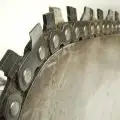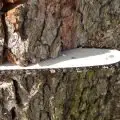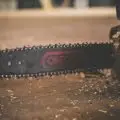As a chainsaw owner, one of the most important maintenance tasks is keeping the chainsaw chain in good condition. However, like all moving parts, chainsaw chains can experience wear and tear over time, and this can lead to chain stretch.
In this article, we will explore the question of do chainsaw chains stretch, the causes of chain stretch, the symptoms of a stretched chain, and how to fix a stretched chainsaw chain.

Table of Contents
- Do Chainsaw Chains Stretch?
- How Do Chainsaw Chains Stretch?
- What Causes a Chainsaw Chain to Stretch?
- Can a Chainsaw Chain Stretch Out?
- What Are the Symptoms of Chain Stretch?
- How to Fix a Stretched Chainsaw Chain
- FAQs (Frequently Asked Questions)
Do Chainsaw Chains Stretch?
The short answer is yes, chainsaw chains can stretch. In fact, it is a common problem that many chainsaw owners experience. A chainsaw chain is made up of a series of metal links that are held together by rivets. As the chain rotates around the guide bar, the metal links rub against each other, and this can cause the chain to stretch over time.
How Do Chainsaw Chains Stretch?
Chain stretch occurs when the distance between the rivets in the chain increases. This can happen for several reasons, including:
- Wear and tear
- Overheating
- Incorrect tension
- Worn sprocket
- Damaged guide bar
Wear and Tear
Over time, the metal links in the chain can become worn, causing the chain to stretch. This is especially true if the chain is not properly maintained, such as being cleaned and lubricated regularly.
Overheating
If the chain becomes overheated during use, the metal links can expand, causing the chain to stretch. Is your Chainsaw Bar Overheating? Learn more here!
Incorrect Tension
If the chain is not properly tensioned, it can cause the chain to stretch over time. This is because an overtightened chain can cause excessive friction and wear, while an under-tightened chain can cause the chain to bounce around, leading to uneven wear.
Learn How Tight Should a Chainsaw Chain Be? in our guide to keeping the right chainsaw tension!
Worn Sprocket
If the sprocket is worn, it can cause the chain to slip, leading to a loose chain.
Damaged Guide Bar
If the guide bar is damaged, it can cause the chain to slip, leading to a loose chain.
What Causes a Chainsaw Chain to Stretch?
In addition to the above reasons, there are several other factors that can contribute to chain stretch. These include:
- Age
- Frequency of use
- Type of wood
As a chainsaw chain gets older, it becomes more susceptible to stretching due to wear and tear. The more often you use your chainsaw, the more likely it is that the chain will stretch. Different types of wood can have different levels of hardness, and this can affect how quickly types of chainsaw chains stretch.
Can a Chainsaw Chain Stretch Out?
Yes, a chainsaw chain can stretch out. Over time, the metal links in the chain can become worn, causing the chain to stretch. This can lead to a number of issues, including a loss of cutting power and increased wear and tear on the chainsaw itself.
What Are the Symptoms of Chain Stretch?
The symptoms of chain stretch can vary depending on the severity of the stretching and other factors. However, some of the most common symptoms of chain stretch include:
- Reduced cutting performance
- Excessive noise
- Difficulty starting the chainsaw
- Increased vibration
- Loose chain
Reduced Cutting Performance
One of the most noticeable symptoms of chain stretch is reduced cutting performance. As the chain becomes longer due to stretching, it can become less effective at cutting through wood, resulting in slower and less efficient performance.
Excessive Noise
A stretched chain can also cause excessive noise while in use. This is because the chain may start to rub against the guide bar or other parts of the chainsaw, creating a loud and unpleasant sound.
Difficulty Starting the Chainsaw
A stretched chain can also make it difficult to start the chainsaw. This is because the chain may not be properly aligned with the drive sprocket, preventing the engine from turning over properly.
If you’re having difficulty with your chainsaw not starting, we have multiple troubleshooting pages available to help:
Increased Vibration
Another symptom of chain stretch is increased vibration. As the chain becomes longer, it can start to wobble and vibrate excessively while in use, which can be uncomfortable and even dangerous for the operator.
Loose Chain
A stretched chain can also become loose or saggy, which can increase the risk of the chain jumping off the guide bar while in use. A loose chain can also cause damage to the guide bar and other parts of the chainsaw. Visit our Chainsaw Chain Keeps Coming Loose? to learn more!
It’s important to address these symptoms as soon as possible to prevent further damage to your chainsaw and ensure that it continues to operate safely and effectively. If you notice any of these symptoms, it’s a good idea to inspect your chainsaw chain for signs of stretching and adjust it as necessary.
How to Fix a Stretched Chainsaw Chain
Fortunately, fixing a stretched chainsaw chain is a relatively simple process that can be done at home. Here’s how to do it:
How to Fix a Stretched Chainsaw Chain
Total Time: 15 minutes
Remove the chain from the chainsaw
Start by removing the chain from the chainsaw. This can usually be done by loosening the tension screw and removing the cover plate.
Inspect the chain
Check the chain for signs of wear and tear, such as broken or missing links. If the chain is in good condition, proceed to the next step.
Measure the chain
Use a chain measurement tool to measure the distance between the rivets in the chain. If the distance is longer than the manufacturer’s specifications, the chain is stretched and needs to be adjusted.
Adjust the chain
To adjust the chain, you will need to remove one or more links from the chain. This can be done using a chain breaker tool. Be sure to follow the manufacturer’s instructions carefully.
Reinstall the chain
Once you have adjusted the chain, reinstall it on the chainsaw, making sure that it is properly tensioned.
Test the chainsaw
Start the chainsaw and test it to make sure that it is running smoothly and that the chain is cutting properly.
In conclusion, chainsaw chains can and do stretch over time due to a variety of factors, including wear and tear, overheating, and incorrect tension. However, with proper maintenance and regular inspections, you can prevent chain stretch and ensure that your chainsaw is operating safely and effectively.
If you do experience a stretched chain, it’s important to address the issue as soon as possible to prevent further damage to your chainsaw and ensure that it continues to perform at its best.
Other chainsaw chain-related pages:
- Why Does My Chainsaw Chain Dull so Quickly?
- What Do the Numbers On a Chainsaw Bar & Chainsaw Chain Mean?
- Are Chainsaw Chains Universal?
- How Many Times Can You Sharpen a Chainsaw Chain Before It Needs Replacing?
- What Are Low Kickback Chainsaw Chains?
FAQs (Frequently Asked Questions)
Can a chainsaw chain stretch out?
Yes, chainsaw chains can stretch out over time due to various factors like wear and tear, overheating, and incorrect tension. However, it is important to note that not all chains stretch, and some may last for years without any signs of wear.
What are the symptoms of chain stretch?
The symptoms of a stretched chainsaw chain include reduced cutting performance, excessive noise, difficulty in starting the chainsaw, and increased vibration. You may also notice that the chain is loose or has become longer than its original length.
What causes a drive chain to stretch?
There are several factors that can cause a chainsaw chain to stretch. Some of the common causes include overheating, excessive wear and tear, incorrect tension, and improper maintenance. When the chain gets too hot, the metal expands, which can cause it to stretch. As the chain rubs against the guide bar and other surfaces, it can become worn, leading to stretching over time. If the chain is too loose or too tight, it can cause stretching. A lack of proper lubrication or sharpening can cause excessive wear and stretching of the chain.
Why will my chainsaw chain not stay tight?
If your chainsaw chain will not stay tight, it could be due to several reasons. One possible cause is a stretched chain. Other possible causes include a worn or damaged guide bar, a loose or damaged tensioning screw, or a problem with the chainsaw’s clutch or sprocket. It’s important to identify the underlying cause and address it promptly to prevent further damage to your chainsaw.





